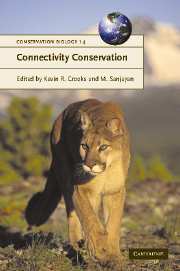Book contents
- Frontmatter
- Contents
- List of contributors
- Acknowledgements
- 1 Connectivity conservation: maintaining connections for nature
- PART I Approaches to connectivity research
- Introduction: Connectivity research—what are the issues?
- 2 Landscape connectivity: a return to the basics
- 3 Connectivity and metapopulation dynamics in highly fragmented landscapes
- 4 Genetics and landscape connectivity
- 5 Connectivity at the land–water interface
- 6 Influence of natural landscape fragmentation and resource availability on distribution and connectivity of gray wolves (Canis lupus) in the archipelago of coastal British Columbia, Canada
- 7 Migratory connectivity
- 8 Connectivity in marine ecosystems: the importance of larval and spore dispersal
- 9 Connectivity and wide-ranging species in the ocean
- 10 Hydrologic connectivity: a neglected dimension of conservation biology
- 11 Connectivity and ecosystem services: crop pollination in agricultural landscapes
- PART II Assessing connectivity
- PART III Challenges and implementation of connectivity conservation
- Index
- References
2 - Landscape connectivity: a return to the basics
Published online by Cambridge University Press: 24 May 2010
- Frontmatter
- Contents
- List of contributors
- Acknowledgements
- 1 Connectivity conservation: maintaining connections for nature
- PART I Approaches to connectivity research
- Introduction: Connectivity research—what are the issues?
- 2 Landscape connectivity: a return to the basics
- 3 Connectivity and metapopulation dynamics in highly fragmented landscapes
- 4 Genetics and landscape connectivity
- 5 Connectivity at the land–water interface
- 6 Influence of natural landscape fragmentation and resource availability on distribution and connectivity of gray wolves (Canis lupus) in the archipelago of coastal British Columbia, Canada
- 7 Migratory connectivity
- 8 Connectivity in marine ecosystems: the importance of larval and spore dispersal
- 9 Connectivity and wide-ranging species in the ocean
- 10 Hydrologic connectivity: a neglected dimension of conservation biology
- 11 Connectivity and ecosystem services: crop pollination in agricultural landscapes
- PART II Assessing connectivity
- PART III Challenges and implementation of connectivity conservation
- Index
- References
Summary
INTRODUCTION
In the decade or so since the concept was formalized in landscape ecology (Taylor et al. 1993) the meaning of the term “landscape connectivity” has become rather diffuse and ambiguous. Many researchers continue to ignore key elements of the original concept, which greatly diminishes its potential utility for land management and the conservation of biodiversity. As originally defined, landscape connectivity is “the degree to which the landscape facilitates or impedes movement among resource patches” (Taylor et al. 1993; see also With et al. 1997). This definition emphasizes that the types, amounts, and arrangement of habitat or land use on the landscape influence movement and, ultimately, population dynamics and community structure. Landscape connectivity thus combines a description of the physical structure of the landscape with an organism's response to that structure. In contrast, common usage generally emphasizes only the structural aspect, where landscape connectivity is simply equated with linear features of the landscape that promote dispersal, such as corridors. Moreover, most commonly employed measures of connectivity focus only on how patch area and inter-patch distances affect movement (e.g., Moilanen and Hanski Chapter 3); such measures ignore the rich complexity of how organisms interact with spatial heterogeneity that may ultimately affect dispersal and colonization success (e.g., interactions with patch boundaries, matrix heterogeneity: Wiens et al. 1993; Wiens 1997; Jonsen and Taylor 2000a).
Information
- Type
- Chapter
- Information
- Connectivity Conservation , pp. 29 - 43Publisher: Cambridge University PressPrint publication year: 2006
References
Accessibility standard: Unknown
Why this information is here
This section outlines the accessibility features of this content - including support for screen readers, full keyboard navigation and high-contrast display options. This may not be relevant for you.Accessibility Information
- 170
- Cited by
